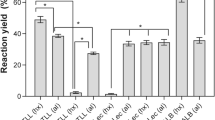Abstract
Ethyl esterification specificity of a lipase from Rhizomucor miehei for polyunsaturated fatty acids (PUFA) was compared at 1 and 100 mM to study molecular recognition of PUFA. The chemical shift of methylene adjacent to carboxyl groups in the nuclear magnetic resonance spectrum of docosahexaenoic acid (DHA) in ethanol moved to a lower magnetic field as the concentration of DHA increased, suggesting that the degree of dissociation of DHA decreased. Specificity constants or apparent second-order rate constants (V max/K m or catalytic power) for 1 mM esterification by immobilized lipases were higher than the native lipase. Immobilized hydrophobic carrier of low mass transfer resistance for the esterification substrate may improve maximal velocity and affinity for the substrate. Higher specificity constants for 1 mM substrates were observed using immobilized lipases fixed on an anion exchange resin with glutaraldehyde and on a cation exchange carrier with carbodiimide. Activity yields measured with 1 mM PUFA substrate were high. For the substrates at a concentration of 100 mM, higher specific constants with these bifunctional reagents were not observed but higher activity yields were found.
Similar content being viewed by others
Abbreviations
- CMC:
-
critical micelle concentration
- DHA:
-
docosahexaenoic acid
- K m or K Ac1X, K Ac2X :
-
Michaelis constant
- NMR:
-
nuclear magnetic resonance
- PUFA:
-
polyunsaturated fatty acid
- V max, V Ac2X, V Ac1X :
-
maximal velocity
References
Sarda, L., and Desnuelle, P. (1958) Action de la lipase pancreatique sur les esters en emulsion, Biochim. Biophys. Acta 30, 513–521.
Brandy, L., Brzozowski, A.M., Derewenda, Z.S., Dodson, E., Dodson, G., Tolley, S., Turkenburg, J.P., Christiansen, L., Huge-Jensen, B., Norskov, L., Thim, L., and Menge, U. (1990) A Serine Protease Triad Forms the Catalytic Centre of a Triacylglycerol Lipase, Nature 343, 767–770.
Brzozowski, A.M., Derewenda, U., Derewenda, Z.S., Godson, G.G., Lawson, D.M., Turkenburg, J.P., Bjorkling, F., Huge-Jensen, B., Patkar, S.A., and Thim, L. (1991) A Model for Interfacial Activation in Lipases from the Structure of a Fungal Lipase-Inhibitor Complex, Nature 351, 491–494.
Kosugi, Y., Qinglong, C., Kanazawa, K., and Nakanishi, H. (1997) Changes in Hydrolysis Specificities of Lipase from Rhizomucor miehei to Polyunsaturated Fatty Acyl Esters in Different Aggregation States, J. Am. Oil Chem. Soc. 74, 1395–1399.
Jones, M.N., and Chapman, D. (1995) The Chemistry and Role of Amphipathic Molecules, in Micelles, Monolayers, and Biomembranes, pp. 1–23, Wiley-Liss, New York.
Deleuze, H., Langand, G., Millet, H., Baratti J., Buono, G., and Triantaphylides, C. (1987) Lipase-Catalyzed Reactions in Organic Media: Competition and Applications, Biochim. Biophys. Acta 911, 117–120.
Rangheard, M.-S., Langland, G., Triantaphylides, C., and Baratti, J. (1989) Multi-Competitive Enzymatic Reactions in Organic Media: A Simple Test for the Determination of Lipase Fatty Acid Specificity, Biochim. Biophys. Acta 1004, 20–28.
Mukherjee, K.D., Kiewitt, I., and Hills, J. (1993) Substrate Specificities of Lipases in View of Kinetic Resolution of Unsaturated Fatty Acids, Appl. Microbiol. Biotechnol. 40, 489–493.
Jachmanian, I., Schulte, E., and Mukherjee, K.D. (1996) Substrate Selectivity in Esterification of Less Common Fatty Acids Catalyzed by Lipases from Different Sources, Appl. Microbiol. Biotechnol. 44, 563–567.
Kosugi, Y., and Suzuki, H. (1992) Functional Immobilization of Lipase Eliminating Lipolysis Product Inhibition, Biotechnol. Bioeng. 40, 369–374.
Kosugi, Y., Igusa, H., and Tomizuka, N. (1987) Glyceride Production from High Free Fatty Acid Rice Bran Oil Using Immobilized Lipase, J. Jpn. Oil Chem. Soc. 36, 769–776.
Foster, R.J., and Niemann, C. (1951) The Kinetics of the α-Chymotrypsin-Catalyzed Competitive Hydrolysis of Acetyl-l-tryptophanamide and Acetyl-l-tyrosineamide in Aqueous Solutions at 25°C and pH 7.9, J. Am. Chem. Soc. 73, 1552–1554.
Katchalski, E., Silman, I., and Goldman, R. (1971) Effect of the Microenvironment on the Mode of Action of Immobilized Enzymes, Adv. Enzymol. 34, 445–536.
Janssen, A.E.M., Vaidya, A.M., and Halling, P.J. (1996) Substrate Specificity and Kinetics of Candida rugosa Lipase in Organic Media, Enzyme Microb. Technol. 18, 340–346.
Koshland, D.E., Jr., and Neet, K.E. (1968) The Catalytic and Regulatory Properties of Enzymes, Annu. Rev Biochem. 37, 359–410.
Author information
Authors and Affiliations
Corresponding author
About this article
Cite this article
Kosugi, Y., Kumar Roy, P., Chang, Q. et al. Esterification of polyunsaturated fatty acids by various forms of immobilized lipase from Rhizomucor miehei . Lipids 35, 461–466 (2000). https://doi.org/10.1007/s11745-000-545-7
Received:
Revised:
Accepted:
Issue Date:
DOI: https://doi.org/10.1007/s11745-000-545-7




